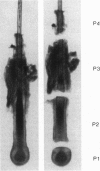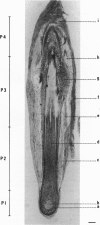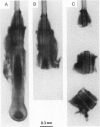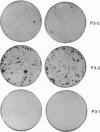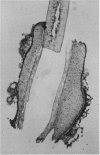Abstract
The epidermis and its related appendages such as the hair follicle constitute the epithelial compartment of the skin. The exact location and distribution of the keratinocyte colony-forming cells within the epidermis or its appendages are unknown. We report that in the rat vibrissa, keratinocyte colony-forming cells are highly clustered in the bulge-containing region. Approximately 95% of the total colonies formed in culture from fractionated vibrissae were in this location and fewer than 4% were located in the matrix area of the follicle. Finer dissection of the bulge-containing region located the colony-forming cells in the small part containing the bulge itself. The segregation of keratinocyte colony-forming cells in the bulge confirms the hypothesis that the bulge is the reservoir of the stem cells responsible for the long-term growth of the hair follicle and perhaps of the epidermis as well.
Full text
PDF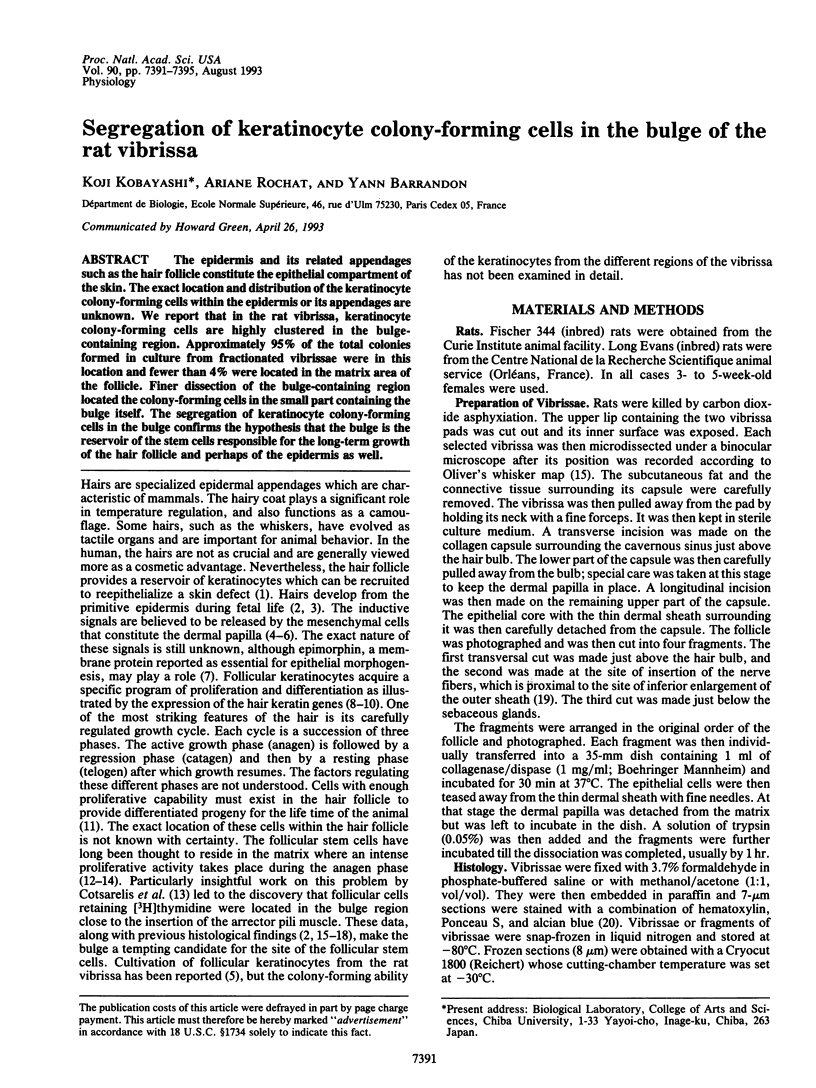
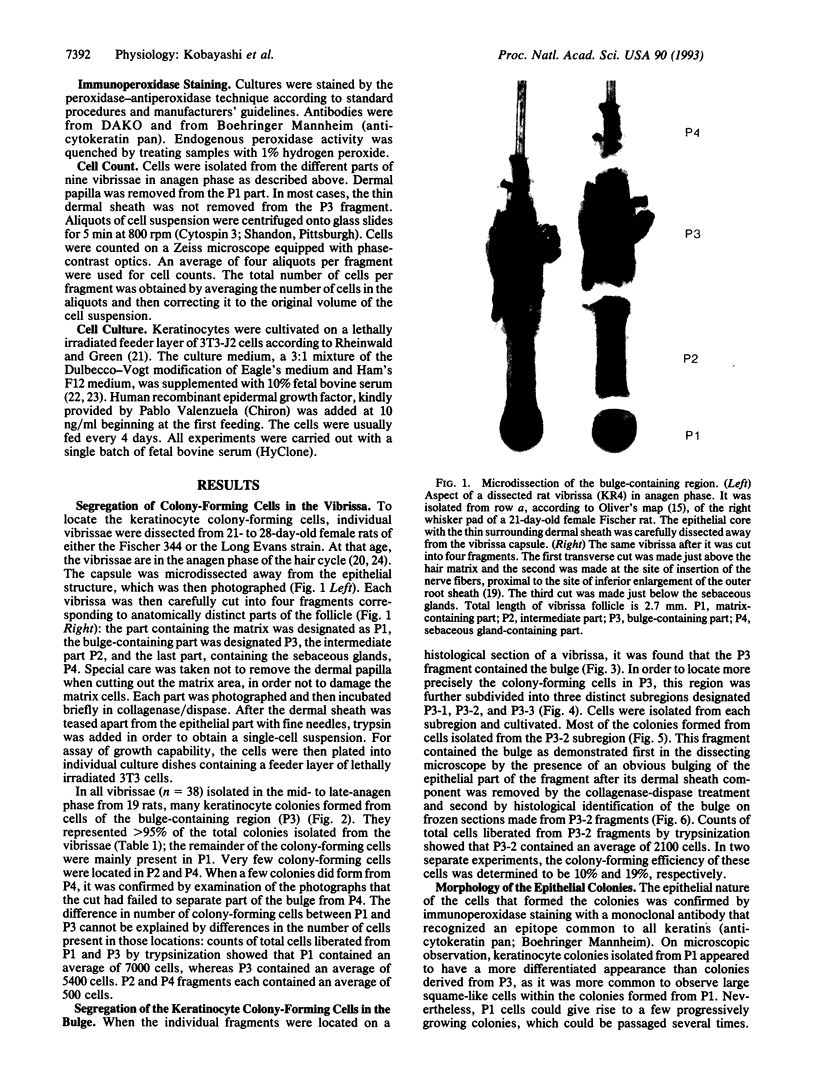
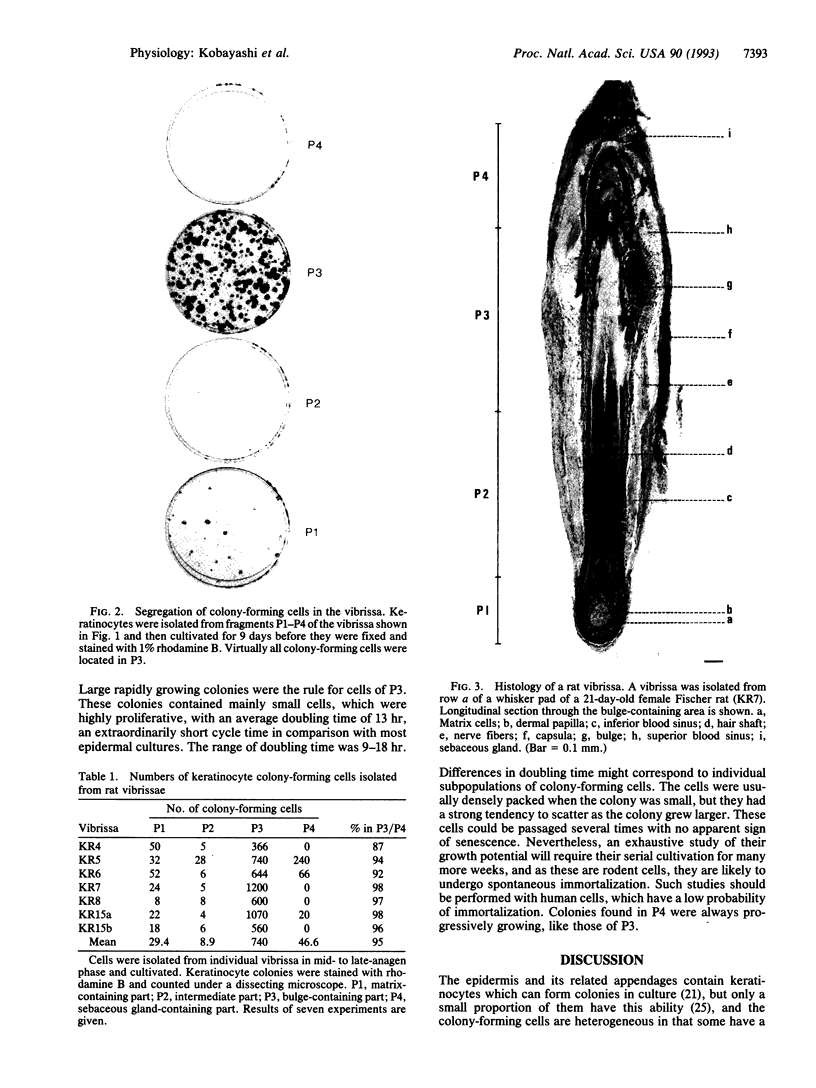
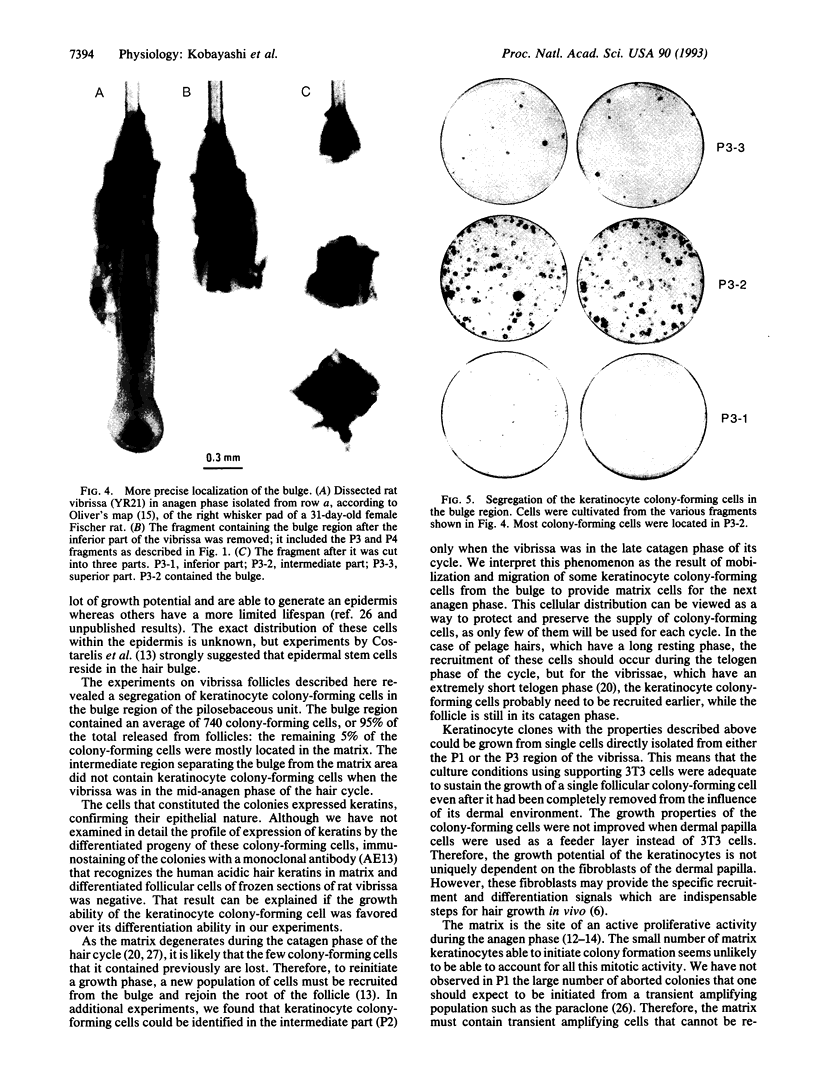
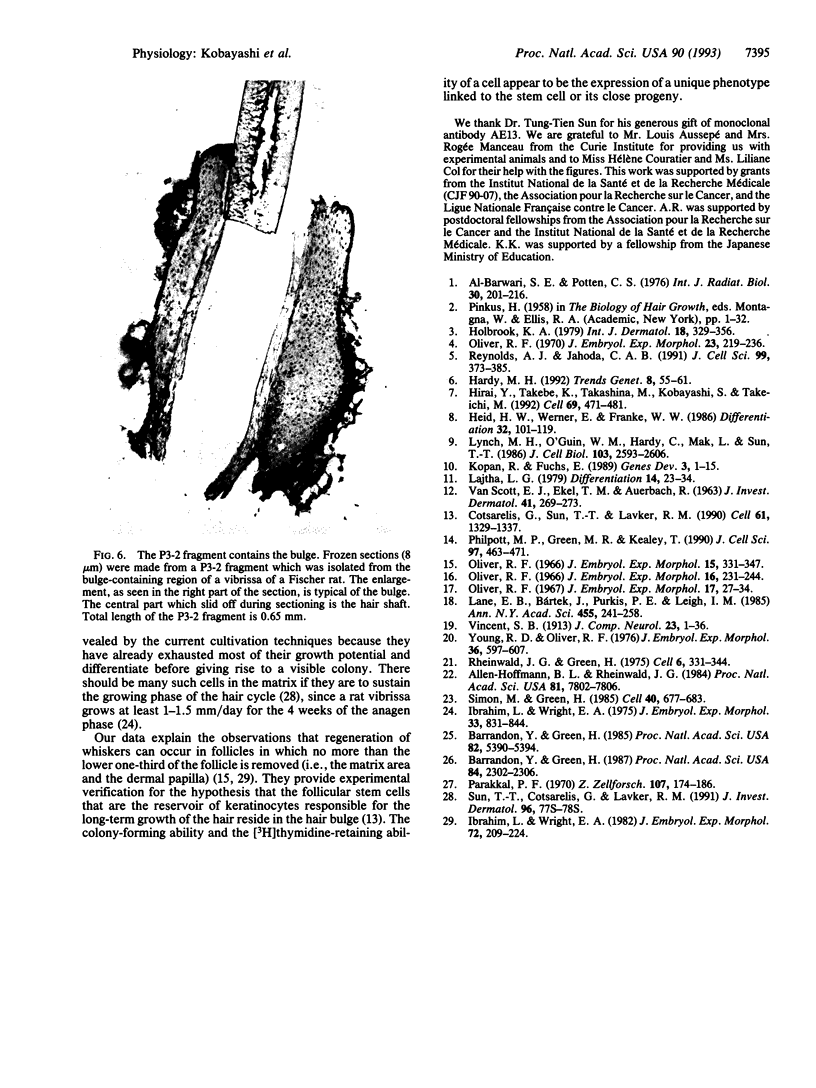
Images in this article
Selected References
These references are in PubMed. This may not be the complete list of references from this article.
- Al-Barwari S. E., Potten C. S. Regeneration and dose-response characteristics of irradiated mouse dorsal epidermal cells. Int J Radiat Biol Relat Stud Phys Chem Med. 1976 Sep;30(3):201–216. doi: 10.1080/09553007614550981. [DOI] [PubMed] [Google Scholar]
- Allen-Hoffmann B. L., Rheinwald J. G. Polycyclic aromatic hydrocarbon mutagenesis of human epidermal keratinocytes in culture. Proc Natl Acad Sci U S A. 1984 Dec;81(24):7802–7806. doi: 10.1073/pnas.81.24.7802. [DOI] [PMC free article] [PubMed] [Google Scholar]
- Barrandon Y., Green H. Cell size as a determinant of the clone-forming ability of human keratinocytes. Proc Natl Acad Sci U S A. 1985 Aug;82(16):5390–5394. doi: 10.1073/pnas.82.16.5390. [DOI] [PMC free article] [PubMed] [Google Scholar]
- Barrandon Y., Green H. Three clonal types of keratinocyte with different capacities for multiplication. Proc Natl Acad Sci U S A. 1987 Apr;84(8):2302–2306. doi: 10.1073/pnas.84.8.2302. [DOI] [PMC free article] [PubMed] [Google Scholar]
- Cotsarelis G., Sun T. T., Lavker R. M. Label-retaining cells reside in the bulge area of pilosebaceous unit: implications for follicular stem cells, hair cycle, and skin carcinogenesis. Cell. 1990 Jun 29;61(7):1329–1337. doi: 10.1016/0092-8674(90)90696-c. [DOI] [PubMed] [Google Scholar]
- Hardy M. H. The secret life of the hair follicle. Trends Genet. 1992 Feb;8(2):55–61. doi: 10.1016/0168-9525(92)90350-d. [DOI] [PubMed] [Google Scholar]
- Heid H. W., Werner E., Franke W. W. The complement of native alpha-keratin polypeptides of hair-forming cells: a subset of eight polypeptides that differ from epithelial cytokeratins. Differentiation. 1986;32(2):101–119. doi: 10.1111/j.1432-0436.1986.tb00562.x. [DOI] [PubMed] [Google Scholar]
- Hirai Y., Takebe K., Takashina M., Kobayashi S., Takeichi M. Epimorphin: a mesenchymal protein essential for epithelial morphogenesis. Cell. 1992 May 1;69(3):471–481. doi: 10.1016/0092-8674(92)90448-l. [DOI] [PubMed] [Google Scholar]
- Holbrook K. A. Human epidermal embryogenesis. Int J Dermatol. 1979 Jun;18(5):329–356. doi: 10.1111/ijd.1979.18.5.329. [DOI] [PubMed] [Google Scholar]
- Ibrahim L., Wright E. A. A quantitative study of hair growth using mouse and rat vibrissal follicles. I. Dermal papilla volume determines hair volume. J Embryol Exp Morphol. 1982 Dec;72:209–224. [PubMed] [Google Scholar]
- Ibrahim L., Wright E. A. The growth of rats and mice vibrissae under normal and some abnormal conditions. J Embryol Exp Morphol. 1975 Jul;33(4):831–844. [PubMed] [Google Scholar]
- Kopan R., Fuchs E. A new look into an old problem: keratins as tools to investigate determination, morphogenesis, and differentiation in skin. Genes Dev. 1989 Jan;3(1):1–15. doi: 10.1101/gad.3.1.1. [DOI] [PubMed] [Google Scholar]
- Lajtha L. G. Stem cell concepts. Differentiation. 1979;14(1-2):23–34. doi: 10.1111/j.1432-0436.1979.tb01007.x. [DOI] [PubMed] [Google Scholar]
- Lane E. B., Bártek J., Purkis P. E., Leigh I. M. Keratin antigens in differentiating skin. Ann N Y Acad Sci. 1985;455:241–258. doi: 10.1111/j.1749-6632.1985.tb50415.x. [DOI] [PubMed] [Google Scholar]
- Lynch M. H., O'Guin W. M., Hardy C., Mak L., Sun T. T. Acidic and basic hair/nail ("hard") keratins: their colocalization in upper cortical and cuticle cells of the human hair follicle and their relationship to "soft" keratins. J Cell Biol. 1986 Dec;103(6 Pt 2):2593–2606. doi: 10.1083/jcb.103.6.2593. [DOI] [PMC free article] [PubMed] [Google Scholar]
- Oliver R. F. Ectopic regeneration of whiskers in the hooded rat from implanted lengths of vibrissa follicle wall. J Embryol Exp Morphol. 1967 Feb;17(1):27–34. [PubMed] [Google Scholar]
- Oliver R. F. Histological studies of whisker regeneration in the hooded rat. J Embryol Exp Morphol. 1966 Oct;16(2):231–244. [PubMed] [Google Scholar]
- Oliver R. F. The induction of hair follicle formation in the adult hooded rat by vibrissa dermal papillae. J Embryol Exp Morphol. 1970 Feb;23(1):219–236. [PubMed] [Google Scholar]
- Oliver R. F. Whisker growth after removal of the dermal papilla and lengths of follicle in the hooded rat. J Embryol Exp Morphol. 1966 Jun;15(3):331–347. [PubMed] [Google Scholar]
- Parakkal P. F. Morphogenesis of the hair follicle during catagen. Z Zellforsch Mikrosk Anat. 1970;107(2):174–186. doi: 10.1007/BF00335223. [DOI] [PubMed] [Google Scholar]
- Philpott M. P., Green M. R., Kealey T. Human hair growth in vitro. J Cell Sci. 1990 Nov;97(Pt 3):463–471. doi: 10.1242/jcs.97.3.463. [DOI] [PubMed] [Google Scholar]
- Reynolds A. J., Jahoda C. A. Hair follicle stem cells? A distinct germinative epidermal cell population is activated in vitro by the presence of hair dermal papilla cells. J Cell Sci. 1991 Jun;99(Pt 2):373–385. doi: 10.1242/jcs.99.2.373. [DOI] [PubMed] [Google Scholar]
- Rheinwald J. G., Green H. Serial cultivation of strains of human epidermal keratinocytes: the formation of keratinizing colonies from single cells. Cell. 1975 Nov;6(3):331–343. doi: 10.1016/s0092-8674(75)80001-8. [DOI] [PubMed] [Google Scholar]
- Simon M., Green H. Enzymatic cross-linking of involucrin and other proteins by keratinocyte particulates in vitro. Cell. 1985 Mar;40(3):677–683. doi: 10.1016/0092-8674(85)90216-8. [DOI] [PubMed] [Google Scholar]
- Sun T. T., Cotsarelis G., Lavker R. M. Hair follicular stem cells: the bulge-activation hypothesis. J Invest Dermatol. 1991 May;96(5):77S–78S. doi: 10.1111/1523-1747.ep12471959. [DOI] [PubMed] [Google Scholar]
- VANSCOTT E. J., EKEL T. M., AUERBACH R. DETERMINANTS OF RATE AND KINETICS OF CELL DIVISION IN SCALP HAIR. J Invest Dermatol. 1963 Nov;41:269–273. [PubMed] [Google Scholar]
- Young R. D., Oliver R. F. Morphological changes associated with the growth cycle of vibrissal follicles in the rat. J Embryol Exp Morphol. 1976 Dec;36(3):597–607. [PubMed] [Google Scholar]



